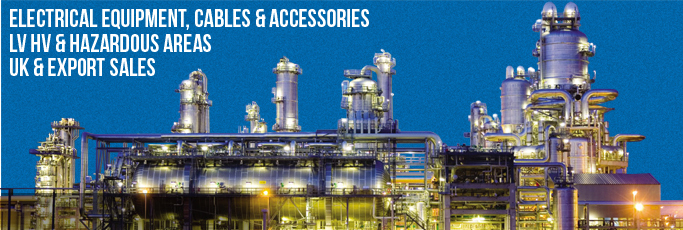
|
|
| home | contact | team t&d | group websites | markets | exports | blog |
 |
|
T&D Working With Aker Solutions on Earth Cables for Indian Offshore Project
By Chris Dodds on 23rd September, 2014

Earth Cables Offshore.
T&D are working on technical specifications for the supply of Earth Cables to Aker Solutions for use in the Indian oil industry. This includes type 1 dynamic cables consisting of plain, multi-stranded annealed copper earth cable with suitable 316 grade stainless steel cable lugs. The electrical connections of the stranded copper earth cables shall be silver soldered by induction heating to the cable lug.
T&D distribute high performance earth braids, earth bonding leads, power shunts, flexible copper busbars, EMC screening braids and flexible copper earth braid products.
T&D custom build copper earth braid and flexible busbar connectors with termination options for switchgear and control panels – this includes power interconnections, earth bonding leads, earth braid assemblies and flexible busbar assemblies for high current applications up to 3500amps.
Customised flexible busbar assemblies meet specific mechanical and electrical performance criteria and provide low resistance heavy duty busbar terminations.
Reliance Industries Limited, Indian Energy Security - Oil
India imports about two-thirds of its crude oil requirement. Exploration and production of oil and gas is critical for India's energy security and economic growth. Reliance's oil and gas exploration and production business is therefore inexorably linked with the national imperative. Exploration and production, the initial link in the energy and materials value chain, remains a major growth area and Reliance envisions evolving as a global energy major.
Energy markets have improved significantly over the past 12-15 months as a result of improved economic growth, higher demand for refined products and limited supplies of crude oil. In 2010, global oil demand grew by 3.4% (or 2.9 MMBD) to 87.9 MMBD, which is the highest growth in the last 30 years. Emerging Asia which comprises India and China, accounted for 40% of the oil demand increase. Global LNG markets also grew by 13% and are currently at 275 million tonnes per annum (MMTPA).
Crude prices increased 25% during the year wherein Brent oil prices averaged $86.7/bbl vis-a-vis $69.5/bbl in FY-10. In FY-11, the US benchmark Henry Hub gas prices averaged $4.13/MMBTU vis-a-vis $3.98/MMBTU in FY-10. Prices remained range-bound in the US due to excess drilling and lack of export infrastructure. However, Asian LNG prices remained linked to crude oil and spot prices in recent months touched $10-12/MMBTU.
It is expected that global energy consumption growth will average at around 1.7% per annum over the next two decades. Of this, non-OECD energy consumption is expected to be 68% higher by 2030, averaging 2.6% p.a. growth, and accounting for 93% of global energy growth. OECD energy consumption in 2030 is expected to be around 6% higher than today, with growth averaging at a measly 0.3% p.a. over the next two decades.
The fuel mix is changing relatively slowly, due to long asset lifetime, but gas and non-fossil fuels are gaining share at the expense of coal and crude oil. The fastest growing fuels are renewables (including biofuels) which are expected to grow at 8.2% p.a. 2010-30; among fossil fuels, gas grows the fastest (2.1% p.a.).
Non-OECD countries are likely to account for 80% of the global rise in gas consumption, with growth averaging at around 3% p.a. Demand growth is expected to be the fastest in non-OECD Asia (4.6% p.a.) and the Middle East (3.9% p.a.). It is expected that over the next two decades, China could consume about 43 BCF per day, which is comparable to that of the 47 BCF per day that EU currently consumes. The growth is expected to remain modest in OECD markets (1% p.a.), particularly in North America.
Oil continues to suffer a long run decline in market share, while gas is steadily gaining. Natural gas is projected to be the fastest growing fossil fuel globally. Production is expected to grow in every region except Europe, with Asia accounting for the world's largest production and consumption increments.
The IEA estimates that global upstream capital spending, which had fallen by 15% in 2009, has rebound in 2010 and is pegged at $ 470 billion. Global offshore capital expenditure is estimated at $ 150 billion and nearly $ 874 billion is expected to be spent over the next five years. A substantial portion of this investment will flow into deepwater. Deep-water capital expenditure is pegged at nearly $ 50 billion and deep-water production is set to double in the next five years. Currently, there are very few fields with water depths of more than 2,000 meters under development. Many of the recent discoveries have been in those water depths. The capital expenditure sanctioned in this water depth is likely to double by 2012.
The role of unconventional oil is also expected to increase significantly and will touch 10% of world oil demand by 2035.
India continues to remain amongst the fastest growing economies of the world with a projected growth of 8-9%. Consequently, India's energy needs are expected to treble by 2035 from 468 million tonnes of oil equivalent (MTOE) to nearly 1405 MTOE. India can fulfill its agenda for climate change as natural gas used to generate power has half the CO2 emissions of conventional coal power generation and near-zero sulphur emissions.
Category: Earthing & Lightning Protection
Sort by Category:
- #ThrowBackThursday
- 3M Scotch Tapes
- ABB Power Products
- Business
- Cable Accessories
- Cable Cleats & Cable Ties
- Cable Containment LV HV
- Cable Crimping & Cutting Tools
- Cable Jointer Training Courses
- Cable Jointing - PhotoBlog
- Cable Labelling & Marking
- Cable Laying & Cable Pulling
- Cable Transits & Duct Sealing
- Company Updates
- Earthing & Lightning Protection
- Electrical Equipment HV
- Electrical Equipment LV
- Electrical Safety & Arc Flash
- Exports
- Flexible Conduit Cable Management
- Hazardous Area Electricals & Lighting
- HV Cable Jointing & Terminating
- LV Cable Jointing & Terminating
- Nexans Euromold Cable Accessories
- Plugs & Sockets
- Power Distribution & Feeder Pillars
- Prysmian FP Cables
- PV Solar Farms
- Rail
- T&D History Blog
- Terms & Conditions of Sale & Purchase
Tweets by @ThorneanDerrick




























